

Civil War
The Esprit has long been Britain’s
only mid-engined supercar,
but now there’s the Noble M12.
Can the old warrior, freshly rejuvenated b y lotus, see off the young pretender?
It’s strangely comforting to note that while Lotus lurches from on financial crisis to the next – canning the front-drive Elan, aborting the potentially brilliant M250 project and halting production of the gemlike Exige along the way – the Esprit’s instinct for survival remains as strong as ever. As it enters its 26th year of production, interest in the wedge-shaped old-timer isn’t exactly frenzied, but the small, international corps of Esprit loyalists is significant enough to ensure Lotus has good reason to remain in the supercar business.
Perversely, the Esprit’s advancing years could be on the the very reasons for its survival. New models may come and go, but as the final link between Lotus and its creator, Colin Chapman, the Esprit it Hethel’s equivalent of the ravens at the Tower of London. Just as legend would have us believe Queen and Country are safe so long as the jet-black birds don’t desert the Thameside castle, so the continued production of the ageing wedge appears to safeguard Lotus from oblivion.
Talisman or not, anything that still looks as good and goes as hard as this ’02 vintage Esprit deserves its continuing place in the pantheon of supercar gods, despite threats from rising demigods like the Noble M12 GTO.
Designed by Lee Noble – a man with Chapmanesque passion for race-bred road cars and similarly intuitive engineering skills – the M12 GTO has quickly gained an enviable reputation (not to mention a sizeable order bank) for prossessing remarkably good dynamics and eye-watering pace. And all despite Noble having a fraction of Lotus’s provenance.
Compare the two cars on paper and you discover that the Esprit and M12 are as evenly matched as a pair of Purdeys. Both have comfortably in excess of 300bhp on tap from their mid-mounted, twin-turbocharged engines, and both can hit 60mph from rest in a shade over four seconds, 100mph in a further six seconds and still have another 70mph or so in reserve. Pricing is the biggest gulf between the two (£45,500 for the M12; £49,950 for the Esprit), but in this league five grand is really neither here nor there.
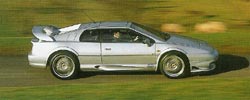

Though inseparable on paper, getting the two cars together on the road was Devil’s own job. In fact if it weren’t for Birmingham-based Nick Whale Sportcars, you wouldn’t be reading this test at all. Britain’s most prolific Lotus dealership (300 new and used cars sold last year), NWS is also an official Noble dealer, and has just taken delivery of not only the first dealer demo M12 in the country but a new-look Esprit V8 as well. In an act of selfless generosity (would you loan us £100,000 worth of supercars?) both cars are ours for a day. Game on.
While waiting for the cars to arrive curbside, I take the opportunity to chat with NWS’s David Noon about the kind of people who buy cars like the Esprit and Noble. He makes an interesting distinction between what you’d think would be ostensibly the same customer.
‘Both Lotus and Noble customers are genuine enthusiasts.
Knowledgeable ones at that. I think the crucial difference is that Lotus customers
buy into the appeal of the brand as much as the car. Someone who buys the
M12 GTO is doing so solely on the strength of the product.’
Looking at the two cars side-by-side, I know which one makes the most fervent
lunge for my fifty grand. It might be the best part of 30 years since Giugiaro’s
gifted pen scribed the Esprit’s paper-dart profile, but there’s
no denying the essential rightness and enduring appeal of his design. Of course
the ’02 Esprit have evolved with the help of former Lotus designers Peter
Stevens and Julian Thomson and current stylist Russell Carr, three talented
men who have all taken turns at sympathetically softening the sharp deges
of the original design during their stints in Norfolk. They’ve done an
excellent job.
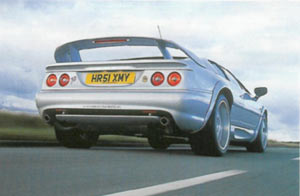
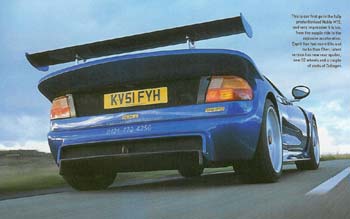
Not that the Noble lacks pavement presence; it too turns heads as effectively as a Wonderbra billboard ad. What it lacks is design deftness of the Lotus. For example, where the Esprit’s front flaunts a crisp convergence of curves, the M12 snout simply looks clunky. It’s a similar story at the back. The Esprit’s new quartet of round rear lights might ape Ferrari, but they also create a far classier image than the pair of old Mondeo lenses that nestle in the Noble’s broad tail. There’s no doubting Lee Noble’s ability as an engineer, but I can’t help thinking the next big step for his company is to enlist the full-time services of a dedicated stylist who can conjure curves as aesthetic as the M12 GTO is athletic.
And jeez, can the GTO run. After the inner-city cut-and-thrust of Birmingham’s city centre – an environment in which I’m pleased to discover the Noble feels calmer and wieldier than it has any right to – the lightly trafficked Peak District roads provide an ideal setting for the first full-on slug of acceleration. Weighting just 980kg dripping wet, the M12 is explosively accelerative, and the first sustained burst of second and third gears prompts a short but highly descriptive stream of expletives from the momentarily frazzled Meaden noggin. Not to mention the most magical mechanical noise this side of a 911 GT2 racer, flat to the boards down the Mulsanne straight.
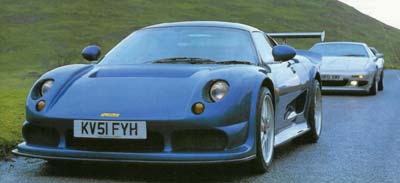
If ever there’s an engine that is immeasurably more than the sum of its parts, it’s the forced-induction V6 that snorts and stuffles in the back of the Noble. All-steel internals and a pair of Garrett T25 turbochargers (the same kind, incidentally, as the Esprit’s) have transformed the rather sluggardly, rev-unhappy Ford motor into one of the most entertaining, charismatic engines in any car at any price. In fact I defy anyone luck enough to experience an M12 GTO not to emerge with a face-splitting smile.
This vibrant engine has the perfect soulmate in the M12’s chassis. Sharp and immediate with no-nonsense response and super-direct steering, the Noble feels as alert and agile as a startled rabbit. What sits it apart is the damping. Where less talented low-volume manufacturers use the term ‘race-bred’ as an excuse for an uncompromisingly hard track setup, Noble’s pure, double-wishbones all-round design uses competition theory but combines in with Koni dampers that deliver a well-judged suppleness. Consequently it feels at home on our less-than-smooth B-roads and copes admirably with bumps, crests and compressions that would have lesser machines skipping off line or scrabbling for grip.

It could do with a bit more feel through the power-assisted steering, especially on initial turn-in, while an awkward, gristly gearshift that feels slow at best and obstructive at worst – especially when trying to hook down into second gear – also detracts from an otherwise exceptionally resolved, rewarding and absorbing drive. Other minor gripes include the driver’s seat, which makes your right buttock numb after half an hour or so of motorway driving, rotary heater dials that have a very sticky, unwilling action, and warning lights that look like they’ve been manufactured in a Third World sweatshop. The last two complaints sound petty, I know, but they are totally at odds with the Noble’s price tag, calibre and aspirations. For an example of how good switchgear can be in a fifty-grand, low-volume car, take a look in any current TVR.
Hang on a minute, though. Stepping out of the Noble into the Lotus, I seem to be swapping one set of ergonomic woes for another. Entering the Esprit’s driver’s seat is akin to entering your house via the letterbox, so tight is the aperture between door panel, seat squab and steering wheel. Once strapped in, your feet get tangled up in the footwell and the sill-mounted handbrake lever is all bout out of reach. The driver’s seat is more comfortable, thanks mainly to a more generously stuffed cushion. Peripheral visibility is on a par with the Noble, by which I mean decidedly restricted, but the view ahead is unique, thanks to the enormous, flat pane of windscreen glass.
Look around the restricted confines of the interior and you’ll spot the old Peugeot switches that line the dashboard (they’re better than the Noble’s but they’re still old Peugeot switches). Equally outdated Vauxhall stalks sprout from the steering column and the infamous Citroen CX mirrors sit atop the doors. Proof that, classy brand image or not, when it comes to parts bin pillaging, Lotus is a past master.
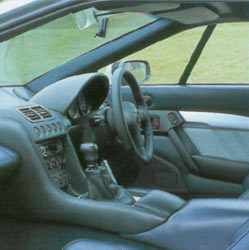
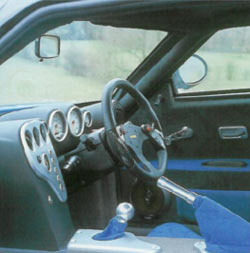
You’d think the a bespoke, 3.5-litre, 350bhp, twin-turbocharged
V8 would be enough to distract you, but having just enjoyed the mellifluous
Noble, the busy, coarse and slightly thrummy Lotus engine is an aural disappointment.
The flat-plane crank doesn’t help its sonic cause, but we all know Ferrari
can make similar hardware sing, so the first thing any prospective Esprit
customer should do is tick the sports exhaust option.
Never mind. Exploration of the further reaches of the throttle’s travel
catapults you down the road. The Esprit might seem low-tech compared with
the aluminum and glue Elise, but power like this is timeless. Delivered in
a slightly more linear way than the furious Noble, there’s still a heart-pumping
step-up in pace as both Garretts spool up, and a relentless hunger for higher
and higher gears to be thrown at it.
Famed for having a duff gearbox for as long as I can remember,
the Esprit’s shift is actually better than the Noble’s. Though it
still feels imprecise and rubbery, it doesn’t share the M12 ‘box’s
baulky, cantankerous nature and you feel more confident of downshifting cleanly.
The pedals aren’t ideally placed for fancy footwork, which is always
frustrating in a car that encourages you to practice your heel-and-toe technique.
What shines out at you though is the quality of the steering. It sounds foolish,
but even after a day behind the wheel I had to check the specification to
confirm that it was in fact power-assisted, such is the consistent, textural
feel from the wheel. As you’d hope of a bigger, more powerful car, it
has a more substantial weight than the Elise’s (unassisted) helm but
it loses none of the intimacy. It really is so good that apart from the raw,
horizon-yanking acceleration, the steering is without doubt the focal point
of the driving experience. In this respect at least, the Noble can’t
compete.
A close second is the damping, which has a brilliantly sophisticated feel, absorbing surface changes and irregularities with cool assurance. The fact that the Esprit’s perilously low nose rarely ploughs the tarmac, even at high speed through roller coaster compressions, is testament to brilliant body control.
Don’t think the Esprit is without dynamic flaw, though.
The lack of a limited-slip differential can be frustrating in wet or damp
conditions when accelerating out of tight corners or junctions, for when the
ample boost kicks-in the inside rear wheel dissolves in a flurry of spinning
histrionics. You can drive around it by flexing the V8’s muscular low-rev
torque, but it’s a technique that feels at odds with how you want to
drive the car.
Which is the better car is a painfully close call. For me the Lotus wins the
visual battle, but as both the Esprit and M12 have different but equally desirable
dynamic attributes, the decision is extremely difficult. If charisma counts,
you’ll fall so deeply in love with the Noble not even the Esprit’s
inspirational steering feel will sway you, but personally every time I got
back into the Lotus its chassis just felt that bit more polished. Not by much,
but enough.
There’s more to the Esprit’s win than a marginal chassis advantage. Despite the company’s woes, don’t underestimate the power of that green and yellow badge. Just as it took TVR many, many years to build cars that are truly worthy of comparison with the best from Porsche, Mercedes and BMW, so it will take Noble a few more years to attain a similar level of acceptance. You can’t buy history; it has to be made. That the M12 GTO can run the Esprit so close, a car, don’t forget, that has been developed and refined over the last three decades, is proof that Noble is going the right way about it.
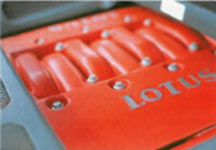
Specification
Lotus Esprit V8
Engine: V8, 3506cc, dohc per bank,
24v twin Garrett T25 turbochargers
Max power: 350bhp @ 6500rpm
Max torque: 295lb ft @ 4250rpm
Transmission: Five-speed manual, rear-wheel drive
Suspension: Doube wishbones front, upper and lower links rear, with
coil springs and gas dampers
Steering: Rack and pinion, power-assisted
Brakes: Ventilated discs, front and rear
Wheels: 8.5 x 17in front, 9.5 x 18in rear, alloy
Tyres: 235/40 ZR17 front, 285/40 ZR18 rear
Weight: 1380 kg
Power-to-weight: 258bhp/ton
0-60mph: 4.8sec (claimed)
0-100mph: 10.5 sec (claimed)
Max speed: 175mph (claimed)
Price: £49,995
Evo Rating: 4 stars
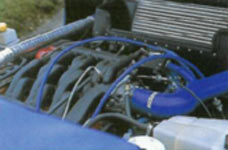
Specification
Noble M12 GTO
Engine: V6, 2544cc, dohc per bank,
24v twin Garrett T25 turbochargers
Max power: 310bhp @ 6000rpm
Max torque: 320lb ft @ 3500rpm
Transmission: Five-speed manual, rear-wheel drive
Suspension: Doube wishbones with coil springs and gas dampers front
and rear
Steering: Rack and pinion, power-assisted
Brakes: Ventilated discs, front and rear
Wheels: 8.5 x 18in front, 10 x 18in rear, alloy
Tyres: 225/40 ZR18 front, 265/35 ZR18 rear
Weight: 980 kg
Power-to-weight: 321bhp/ton
0-60mph: 4.1sec
0-100mph: 10.2 sec
Max speed: 165mph (claimed)
Price: £45,500
Evo Rating: 4 stars

|
|